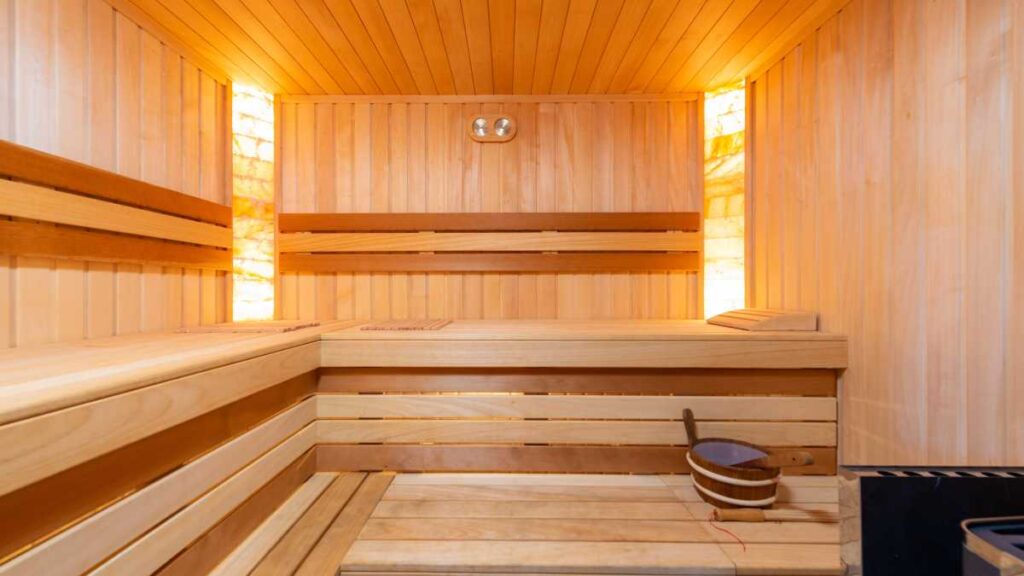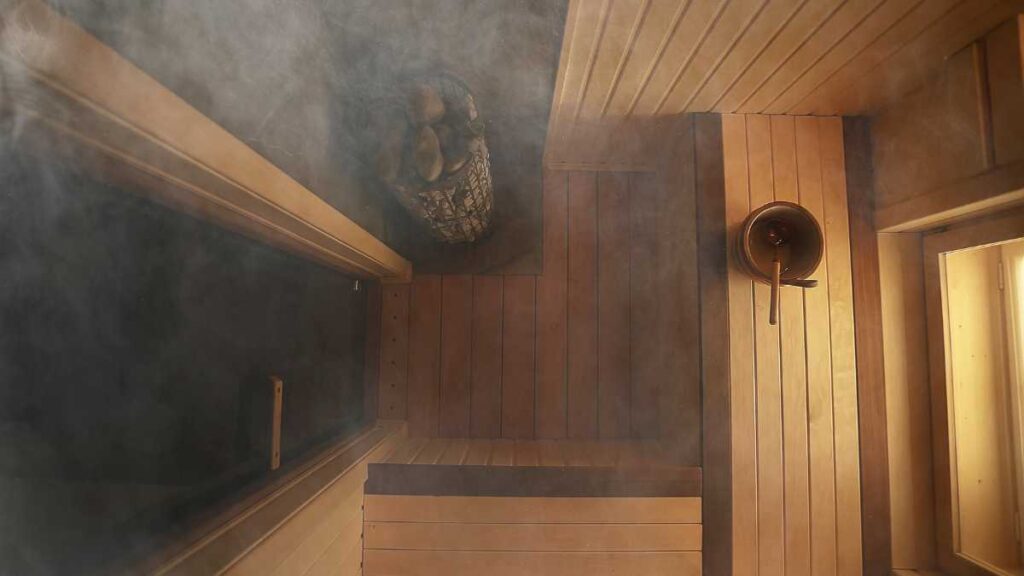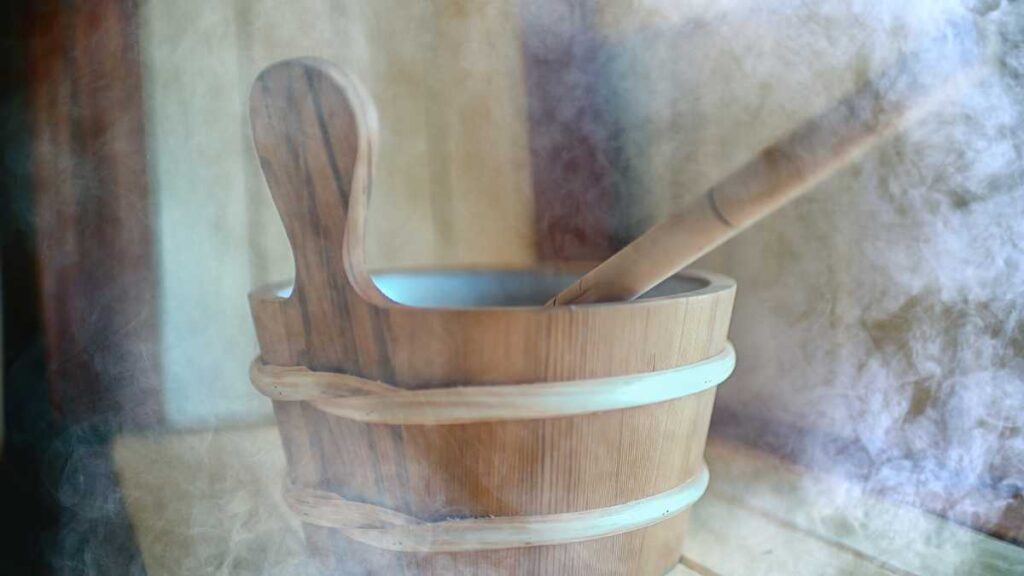You step into the sauna, and the heat wraps around you like a heavy blanket. At first, it feels incredible.
Your muscles relax, your stress melts away, and for a moment, you feel completely at ease.
But then, the intensity kicks in. Sweat starts pouring, your heart pounds, and suddenly, the heat feels overwhelming.
You wonder how hot should a Sauna be? The ideal sauna temperature varies by type. Traditional saunas should be 150–195°F (65–90°C), while infrared saunas range from 120–150°F (50–65°C). Steam rooms are cooler at 100–120°F (38–50°C) due to high humidity.
But how do you know what’s too much, what’s safe, and what’s most effective?
Understanding the ideal sauna temperature isn’t just about comfort—it’s about maximizing benefits while avoiding risks.
Let’s break it all down so you can find your perfect heat level and make the most of every sauna session.
How Hot Should A Sauna Be? Common Myths

Sauna temperatures can be confusing, especially with all the misconceptions floating around.
Many believe hotter is always better, but that’s not true. Let’s bust some common myths so you can use a sauna safely and effectively.
Myth #1: “The Hotter, The Better.”
Saunas aren’t about testing pain tolerance. Overheating can lead to dehydration, dizziness, and even heat exhaustion. More heat doesn’t always mean more benefits.
Studies suggest that excessive sauna temperatures increase cardiovascular strain, which can be dangerous for some individuals.
Myth #2: “All Saunas Should Be The Same Temperature.”
Not all saunas operate the same way. A traditional Finnish sauna runs between 150–195°F (65–90°C), while an infrared sauna stays around 120–150°F (50–65°C).
Each sauna has a different heating method, humidity level, and intensity. Understanding these differences helps you find what works best for your needs.
Myth #3: “Higher Heat Burns More Calories.”
Yes, sitting in a sauna increases heart rate and sweat loss, but it doesn’t burn fat. Any weight loss from excessive heat is just water loss—you’ll regain it once you rehydrate.
While sauna use can slightly increase metabolism, the effect is modest compared to actual physical exercise.
How Sauna Temperature Affects Metabolism
Saunas slightly increase caloric expenditure due to heat-induced thermogenesis. However, studies suggest that the extra calorie burn is minimal and not enough to drive significant weight loss.
Heat And Calorie Burn
Does Sauna burn calories? the answer is: Saunas slightly increase caloric expenditure due to heat-induced thermogenesis.
Your body works to cool itself down, burning a small number of extra calories.
However, this effect is minimal compared to actual physical exercise. It’s more about supporting recovery and circulation rather than a significant metabolism boost.
Heart Rate And Circulation
Higher temperatures cause blood vessels to expand, increasing oxygen flow to muscles and organs.
This mild cardiovascular response is similar to light aerobic exercise and may contribute to heart health over time.
However, excessive heat can strain the heart, especially if you have preexisting conditions.
Health Benefits of The Right Sauna Temperature
Using a sauna at the right temperature offers incredible health benefits, from muscle recovery to stress relief. However, if the heat is too extreme, the benefits can turn into risks.
Muscle Recovery And Pain Relief
After a workout, heat helps reduce muscle stiffness and increase blood circulation. Studies show saunas can lower post-exercise soreness by up to 47%.
The improved blood flow delivers oxygen and nutrients to tired muscles, speeding up recovery.
Stress Reduction And Mental Health
Heat exposure releases endorphins—natural mood boosters. Many sauna users report reduced stress, better sleep, and improved mental clarity.
The warmth relaxes the nervous system, lowering cortisol levels and promoting a sense of calm.
Immune System Boost
Sauna sessions increase white blood cell production, strengthening your body’s defense against infections. Heat shock proteins also play a role in cell repair and longevity.
Studies suggest that regular sauna use may reduce the risk of colds and improve overall immunity.
Sauna Temperature Guidelines by Type

Different saunas run at different temperatures. Here’s what you need to know:
| Sauna Type | Temperature Range |
|---|---|
| Traditional Finnish Sauna | 150–195°F (65–90°C) |
| Infrared Sauna | 120–150°F (50–65°C) |
| Steam Room | 100–120°F (38–50°C) |
How to Choose the Right Heat
- Beginners: Start at lower temperatures and work your way up.
- Athletes And Recovery: Stick to moderate heat (140–170°F) for best results.
- Health Conditions: People with heart problems or high blood pressure should use lower temperatures and consult a doctor.
Factors That Influence Your Ideal Sauna Temperature
Everyone tolerates heat differently. Here are some key factors that affect your ideal sauna temperature:
Experience Level
- New to saunas? Start at 120–140°F and build heat tolerance.
- Experienced users? You may enjoy 175°F or higher, but don’t push past comfort.
Health Conditions
- Heart conditions, high blood pressure, or pregnancy? Stick to lower heat levels and consult a doctor.
- Dehydration risks? Avoid excessive sweating at extreme temperatures.
External Climate
A hot summer day vs. a freezing winter evening changes how your body reacts. If you’re already warm, lower the sauna temperature.
Signs Your Sauna Is Too Hot
Ignoring warning signs can be dangerous. Watch for these red flags:
Dizziness, Nausea, Or Weakness
Your body struggles to regulate temperature. This means it’s time to step out and cool down.
Heat Exhaustion vs. Heat Stroke
- Heat exhaustion: Heavy sweating, fatigue, lightheadedness.
- Heat stroke: Confusion, no sweating, rapid pulse—this is a medical emergency.
Breathing Difficulty
Excessive heat can make the air feel heavy, causing discomfort or difficulty breathing. If this happens, exit immediately.
How To Maximize Your Sauna Experience
Getting into a sauna is easy—but are you making the most of it? Many people either stay too long, don’t hydrate enough, or use the wrong temperature for their goals.
A sauna should leave you rejuvenated, not drained. Follow these steps to optimize your session and get the best results.
Hydrate Before And After
Sweating depletes water and essential electrolytes, so proper hydration is crucial.
- Before your session: Drink at least 16–20 oz of water 30–60 minutes prior. This prepares your body to handle heat loss.
- During your session: If using high temperatures, take small sips of water between breaks.
- After your session: Rehydrate immediately with water, coconut water, or electrolyte drinks to replace lost minerals.
Avoid alcohol or caffeine before a sauna—they increase dehydration and stress your heart.
Best Time For Sauna Sessions
When you sauna can impact how you feel throughout the day.
- Morning Sauna: Helps boost circulation, wake you up, and energize you for the day. It also aids in loosening stiff muscles.
- Post-Workout Sauna: Enhances muscle recovery by improving blood flow and flushing out metabolic waste.
- Evening Sauna: Relaxes muscles, calms the nervous system, and improves sleep quality. This is ideal for stress relief after a long day.
Try different times to see what works best for your energy levels and routine.
Ideal Duration By Temperature
How long should you sit in the sauna? It depends on the heat level and your experience.
| Sauna Temperature | Recommended Duration |
|---|---|
| Low heat (120–140°F / 50–60°C) | 20–30 minutes (Best for beginners or relaxation) |
| Moderate heat (140–170°F / 60–75°C) | 15–20 minutes (Best for fitness recovery and stress relief) |
| High heat (175–195°F / 80–90°C) | 10–15 minutes (Best for experienced users, intense sweating) |
Listen to your body—if you feel dizzy, lightheaded, or overheated, exit immediately.
Common Mistakes To Avoid In Sauna Use

Many people use saunas incorrectly without realizing it. From overstaying to not drinking enough water, small mistakes can lead to discomfort, dehydration, or even health risks.
Here’s what to avoid:
Staying In Too Long
More heat does not mean more benefits—staying past your limit can lead to dehydration, heat exhaustion, or dizziness.
- Beginners should start with 10–15 minutes at a lower temperature.
- Experienced users can increase to 20–30 minutes, depending on tolerance.
- If you start feeling dizzy, lightheaded, or nauseous, exit immediately and cool down.
Not Adjusting for Health Conditions
Sauna use affects the heart, blood pressure, and hydration levels. If you have certain health conditions, you need to modify your approach.
- Heart problems or high blood pressure? Stick to lower temperatures (120–140°F) and shorter sessions (10–15 minutes).
- Pregnant? Consult a doctor first—excessive heat can be dangerous for the baby.
- Sensitive to heat? Choose infrared saunas (lower heat but deeper tissue penetration).
Skipping Cool-Down and Hydration
A proper cool-down is just as important as the sauna session itself.
- After leaving the sauna, sit in a cool (but not cold) area for 5–10 minutes. Let your body return to normal temperature gradually.
- Rehydrate immediately with at least 16–24 oz of water to replace lost fluids.
- If you feel weak or lightheaded, drink an electrolyte solution to restore balance.
Pro Tip: A cold shower after the sauna boosts circulation, reduces muscle inflammation, and enhances recovery.
Conclusion
Finding the right sauna temperature is about balance, not endurance. Many people assume that higher heat equals better results, but that’s not always true.
Staying within a safe range—150–195°F for traditional saunas and 120–150°F for infrared saunas—ensures you get the benefits without pushing your body too far.
Heat should work with you, not against you. If you’re lightheaded, dizzy, or struggling to breathe, it’s a sign to step out and cool down.
Your ideal sauna experience depends on your tolerance, health, and hydration levels. Beginners should start with lower temperatures and shorter sessions, while experienced users can gradually increase heat exposure.
But no matter your level, listening to your body is key. A sauna should leave you feeling refreshed, not drained.
When used wisely, the right temperature enhances recovery, reduces stress, and improves overall well-being—making every session worth it.













